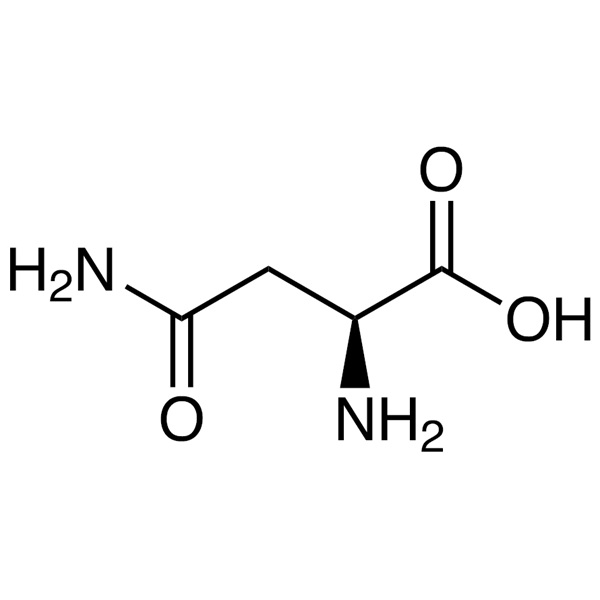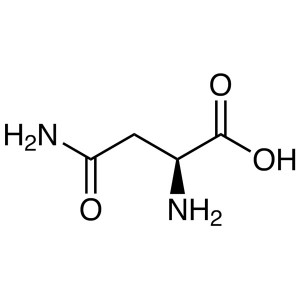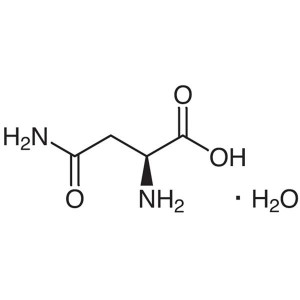L-Asparagine Anhydrous CAS 70-47-3 (H-Asn-OH) Assay 99.0~101.0% Factory High Quality
Shanghai Ruifu Chemical Co., Ltd. is the leading manufacturer and supplier of L-Asparagine Anhydrous (Asn Anhydrous) (CAS: 70-47-3) with high quality, production capacity 100 tons per year. Ruifu Chemical supplys a series of amino acids and derivatives. We can provide worldwide delivery, small and bulk quantities available. If you need L-Asparagine Anhydrous, Please contact: alvin@ruifuchem.com
L-Asparagine Monohydrate (H-Asn-OH·H2O) CAS 5794-13-8
L-Asparagine Anhydrous (Asn Anhydrous; H-Asn-OH) CAS 70-47-3
| Chemical Name | L-Asparagine Anhydrous |
| Synonyms | Asn Anhydrous; Asn; H-Asn-OH; L-Asparagine; L-(+)-Asparagine; Laevo-Asparagine; Asparagine; L-Aspartic Acid 4-Amide Anhydrous; (S)-2-Aminosuccinic Acid 4-Amide Anhydrous; Aspartamic Acid; Agedoite; Altheine; L-2,4-Diamino-4-Oxobutanoic Acid; L-Aspartamine; L-β-Asparagine |
| Stock Status | In Stock, Production Capacity 100 Tons per Year |
| CAS Number | 70-47-3 |
| Molecular Formula | C4H8N2O3 |
| Molecular Weight | 132.12 |
| Melting Point | 235℃(dec.) (lit.) |
| Density | 1.543 |
| Sensitive | Hygroscopic |
| Water Solubility | Soluble in Water, 20g/L (20℃) |
| Solubility | Soluble in Acids, Bases. Insoluble in Methanol, Ethanol, Ether, Benzene |
| Odor | Slightly Sweet Taste |
| Storage Temp. | Sealed in Dry, Store at Room Temperature |
| COA & MSDS | Available |
| Classification | Amino Acids & Derivatives |
| Brand | Ruifu Chemical |
| Hazard Codes | Xn | F | 3-10 |
| Risk Statements | 20/21/22-36/37/38 | TSCA | Yes |
| Safety Statements | 24/25-36-26 | Hazard Class | Irritant |
| RIDADR | UN 2811 6.1 / PGIII | HS Code | 2922491990 |
| WGK Germany | 3 |
| Items | Inspection Standards | Results |
| Appearance | White Crystals or Crystalline Powder | Conforms |
| Identification | Infrared Absorption Spectrum | Conforms |
| Specific Rotation [α]20/D | +34.2° to +36.5° (C=10, 3N HCl) |
+34.8° |
| Transmittance | ≥98.0% | 98.6% |
| Chloride (Cl) | ≤0.020% | <0.020% |
| Sulfate (SO4) | ≤0.020% | <0.020% |
| Ammonium (NH4) | ≤0.100% | <0.100% |
| Iron (Fe) | ≤10ppm | <10ppm |
| Heavy Metals (as Pb) | ≤10ppm | <10ppm |
| Arsenic (As2O3) | ≤1.0ppm | <1.0ppm |
| Other Amino Acids | ≤1.00% | 0.79% |
| Loss on Drying | ≤0.50% (105℃, 3 Hours) | 0.17% |
| Residue on Ignition (Sulfated) | ≤0.10% | 0.06% |
| Assay | 99.0~101.0% (on Dried Basis) | 99.3% |
| pH Value | 4.4 to 6.4 | 4.6 |
| Microbiology Test | ||
| Total Plate Count | ≤1000cfu/g | Conforms |
| Yeast & Mold | ≤100cfu/g | Conforms |
| E.Coli | Negative | Negative |
| Salmonella | Negative | Negative |
| Conclusion | Accords with the AJI97 / USP35 Standard | |
Asparagine is anhydrous, or contains one molecule of water of hydration. It contains NLT 98.0% and NMT 101.5% of C4H8N2O3, as L-asparagine, calculated on the dried basis
IDENTIFICATION
• A. INFRARED ABSORPTION <197K>
[NOTE-Use USP Asparagine Anhydrous RS and USP Asparagine Monohydrate RS for the evaluation of the anhydrous and monohydrate forms of Asparagine, respectively.]
ASSAY
• PROCEDURE
Sample: 130 mg
Titrimetric system
(See Titrimetry <541>.)
Mode: Direct titration
Titrant: 0.1 N perchloric acid VS
Blank: 3 mL of formic acid in 50 mL of glacial acetic acid
Endpoint detection: Potentiometrically
Analysis: Dissolve the Sample with 3 mL of formic acid in 50 mL of glacial acetic acid. Perform a blank determination.
Calculate the percentage of asparagine (C4H8N2O3) in the Sample taken:
[(V − B) × N × F × 100]/W
V= volume of Titrant consumed by the Sample (mL)
B = volume of Titrant consumed by the Blank (mL)
N = actual normality of the Titrant (mEq/mL)
F = equivalency factor for asparagine, 132.1 mg/mEq
W = weight of the Sample (mg)
Acceptance criteria: 98.0%-101.5% on the dried basis
IMPURITIES
• RESIDUE ON IGNITION <281>
Sample: 1.0 g
Acceptance criteria: NMT 0.1%
• LEAD <251>
Sample: 1 g
Control: 5 mL of Diluted Standard Lead Solution (5 µg of Pb)
Acceptance criteria: NMT 5 ppm
• CHROMATOGRAPHIC PURITY
Standard solution: 0.05 mg/mL of USP Asparagine Anhydrous RS or USP Asparagine Monohydrate RS
[NOTE-Use USP Asparagine Anhydrous RS and USP Asparagine Monohydrate RS for the evaluation of the anhydrous and monohydrate forms of Asparagine, respectively.]
Sample solution: 10 mg/mL
Chromatographic system
(See Chromatography <621>, Thin-Layer Chromatography.)
Adsorbent: 0.25-mm layer of chromatographic silica gel mixture
Application volume: 5 µL
Developing solvent system: Butyl alcohol, glacial acetic acid, and water (3:1:1)
Spray reagent: 2 mg/mL of ninhydrin in butyl alcohol and glacial acetic acid (19:1)
Analysis
Samples: Standard solution and Sample solution
Proceed as directed in the general test chapter, and then dry the plate at 80° for 30 min. Spray the plate with the Spray reagent, heat at 80° for 10 min, and examine under white light.
Acceptance criteria: No secondary spot from the Sample solution is larger or more intense than the principal spot from the Standard solution (0.5%), and NMT 1.0% of total impurities is found.
SPECIFIC TESTS
• OPTICAL ROTATION, Specific Rotation <781S>
Sample solution: 10 mg/mL, in 6 N hydrochloric acid
Acceptance criteria: +33.0° to +36.5°, measured at 20°
• MICROBIAL ENUMERATION TESTS <61> and TESTS FOR SPECIFIED
MICROORGANISMS <62>: The total aerobic microbial count does not exceed 1000 cfu/g, and the total combined molds and yeasts count does not exceed 100 cfu/g.
• LOSS ON DRYING <731>: Dry a sample at 130° for 3 h: the anhydrous form loses NMT 1.0% of its weight, and the monohydrate loses between 11.5% and 12.5% of its weight.
ADDITIONAL REQUIREMENTS
• PACKAGING AND STORAGE: Preserve in well-closed, light-resistant containers. Store at room temperature.
• LABELING: Label it to indicate whether it is anhydrous or the monohydrate.
• USP REFERENCE STANDARDS <11>
USP Asparagine Anhydrous RS
USP Asparagine Monohydrate RS
Package: Fluorinated Bottle, Aluminium foil bag, 25kg/Cardboard Drum, or according to customer's requirement.
Stability: Stable, but may be moisture-sensitive. Incompatible with strong oxidizing agents.
Storage Condition: Store in sealed containers at cool, dry and ventilated warehouse away from incompatible substances. Protect from light and moisture.
How to Purchase? Please contact Dr. Alvin Huang: sales@ruifuchem.com or alvin@ruifuchem.com
15 Years Experience? We have more than 15 years of experience in the manufacture and export of a wide range of high quality pharmaceutical intermediates or fine chemicals.
Main Markets? Sell to domestic market, North America, Europe, India, Korea, Japanese, Australia, etc.
Advantages? Superior quality, affordable price, professional services and technical support, fast delivery.
Quality Assurance? Strict quality control system. Professional equipment for analysis include NMR, LC-MS, GC, HPLC, ICP-MS, UV, IR, OR, K.F, ROI, LOD, MP, Clarity, Solubility, Microbial limit test, etc.
Samples? Most products provide free samples for quality evaluation, shipping cost should be paid by customers.
Factory Audit? Factory audit welcome. Please make an appointment in advance.
MOQ? No MOQ. Small order is acceptable.
Delivery Time? If within stock, three days delivery guaranteed.
Transportation? By Express (FedEx, DHL), by Air, by Sea.
Documents? After sales service: COA, MOA, ROS, MSDS, etc. can be provided.
Custom Synthesis? Can provide custom synthesis services to best fit your research needs.
Payment Terms? Proforma invoice will be sent first after confirmation of order, enclosed our bank information. Payment by T/T (Telex Transfer), PayPal, Western Union, etc.
Asparagine [symbol Asn or N] is a key α-amino acid that is used in the biosynthesis of proteins. It contains a α-amino group and a α-carboxylic acid group as well as a side chain carboxamide. It is classified as a polar [at physiological pH], aliphatic amino acid. It is non-essential in humans, and can undergo de novo synthesis inside the human body. From the aspect of genetic code during protein synthesis, it is encoded by the codons AAU and AAC. L-Asparagine is an uncharged derivative of aspartate.
Application of L-Asparagine Anhydrous (Asn Anhydrous) (CAS: 70-47-3)
1. In medicine, L-Asparagine can be used to treat heart disease, liver disease, hypertension, with the effect of preventing and restoring fatigue. Together with a variety of amino acids, it can be made into amino acid infusion, used as ammonia antidote, liver function promoter, fatigue recovery agent
L-Asparagine is a drug that is used for lowering blood pressure, dilating bronchus (asthma), anti-peptic ulcer and gastric dysfunction. Lowering blood pressure, dilating bronchus (asthma), anti-peptic ulcer and gastric dysfunction. Used for microbial culture, sewage treatment of acrylonitrile, etc.
2. In the food industry, L-Asparagine is a good nutritional supplement, added to a variety of cool drinks; It is also the main raw material of sweet monosodium glutamate (aspartame)-aspartate phenylalanine methyl ester.
Asparagine has good function of revealing fresh and the preservation. L-Asparagine widely uses as medicinal preparation or revealing fresh and antiseptic in food profession,and can replace monosodium glutamate.
3. In chemical industry, L-Asparagine can be used as the raw material of synthetic resin and as the nutritional additive of cosmetics.



